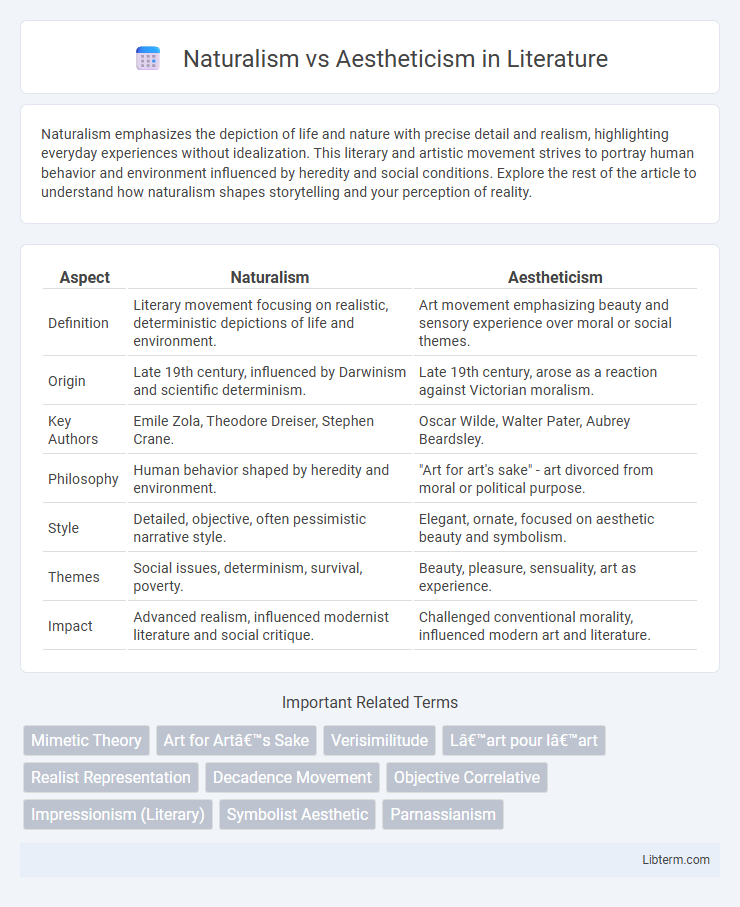Naturalism emphasizes the depiction of life and nature with precise detail and realism, highlighting everyday experiences without idealization. This literary and artistic movement strives to portray human behavior and environment influenced by heredity and social conditions. Explore the rest of the article to understand how naturalism shapes storytelling and your perception of reality.
Table of Comparison
| Aspect | Naturalism | Aestheticism |
|---|---|---|
| Definition | Literary movement focusing on realistic, deterministic depictions of life and environment. | Art movement emphasizing beauty and sensory experience over moral or social themes. |
| Origin | Late 19th century, influenced by Darwinism and scientific determinism. | Late 19th century, arose as a reaction against Victorian moralism. |
| Key Authors | Emile Zola, Theodore Dreiser, Stephen Crane. | Oscar Wilde, Walter Pater, Aubrey Beardsley. |
| Philosophy | Human behavior shaped by heredity and environment. | "Art for art's sake" - art divorced from moral or political purpose. |
| Style | Detailed, objective, often pessimistic narrative style. | Elegant, ornate, focused on aesthetic beauty and symbolism. |
| Themes | Social issues, determinism, survival, poverty. | Beauty, pleasure, sensuality, art as experience. |
| Impact | Advanced realism, influenced modernist literature and social critique. | Challenged conventional morality, influenced modern art and literature. |
Introduction to Naturalism and Aestheticism
Naturalism emphasizes a detailed, objective portrayal of everyday reality, focusing on determinism, social conditions, and the influence of environment and heredity on human behavior. Aestheticism prioritizes art for art's sake, valuing beauty and sensory experience over moral or social themes, often rejecting the utilitarianism of literature. Both movements emerged in the late 19th century as distinct responses to prevailing artistic and cultural norms.
Historical Origins and Development
Naturalism emerged in the late 19th century as a literary movement rooted in scientific determinism and influenced by Darwinian theory, emphasizing objective reality and social environment's impact on human behavior. Aestheticism arose concurrently as a reaction against utilitarian values, championing art for art's sake and prioritizing beauty and sensory experience over moral or social purposes. Both movements shaped modern literature by contrasting the portrayal of life's harsh realities with the pursuit of beauty and artistic expression.
Core Philosophies: Defining Naturalism
Naturalism asserts that reality is governed by natural laws and phenomena, emphasizing observation and scientific methodology to understand human behavior and the world. It rejects supernatural explanations, advocating that everything arises from natural causes and is ultimately knowable through empirical evidence. In contrast, aestheticism prioritizes beauty and sensory experience over objective reality, valuing artistic expression as an end in itself rather than a reflection of the natural world.
Principles of Aestheticism Explained
Aestheticism emphasizes art for art's sake, valuing beauty and sensory experience over moral or social themes, contrasting with Naturalism's focus on depicting reality and social issues objectively. The principles of Aestheticism include prioritizing artistic beauty, rejecting utilitarian or didactic purposes, and celebrating individuality and imagination. Influential figures like Oscar Wilde championed these ideas, advocating that art exists independently of ethical or political functions.
Key Figures and Influential Works
Naturalism, championed by Emile Zola with his novel "Germinal," emphasizes a scientific approach to literature depicting social realities and determinism. Aestheticism, led by Oscar Wilde, particularly through "The Picture of Dorian Gray," prioritizes beauty and art for art's sake, rejecting moral and social themes. These contrasting movements highlight Zola's focus on detailed observation and environment shaping characters, while Wilde underscores art's autonomy and surface elegance.
Art, Literature, and Representation
Naturalism in art and literature emphasizes accurate, detailed depictions of everyday life and social realities, often exploring the influence of environment and heredity on human behavior. Aestheticism prioritizes beauty, form, and sensory experience over moral or social themes, advocating "art for art's sake" and valuing artistic expression as autonomous from utilitarian purposes. Representation in Naturalism seeks verisimilitude and objective truth, while Aestheticism embraces stylization and subjective interpretation to evoke emotional and visual pleasure.
Nature versus Beauty: The Central Debate
Naturalism emphasizes the accurate, unembellished representation of nature, focusing on realism and the raw, often harsh truths of the natural world. Aestheticism champions beauty and artistic expression, valuing subjective interpretation and sensory pleasure over factual accuracy. The central debate hinges on whether art should serve as a mirror to nature or as a celebration of beauty independent of natural reality.
Impact on Modern Thought and Culture
Naturalism's emphasis on empirical observation and social realities shaped modern thought by promoting scientific approaches and challenging idealized representations of life. Aestheticism's focus on art for art's sake influenced modern culture by prioritizing beauty and sensory experience over moral or social utility. Together, these movements redefined artistic and intellectual boundaries, impacting literature, philosophy, and visual arts in the late 19th and early 20th centuries.
Criticisms and Controversies
Naturalism faced criticism for its deterministic outlook and portrayal of life as governed by heredity and environment, which some argued reduced human free will and moral responsibility. Aestheticism sparked controversy for prioritizing beauty and art for art's sake over social or moral themes, leading critics to accuse it of promoting escapism and superficiality. Both movements challenged traditional literary values, provoking debates on the purpose and ethical implications of art in society.
Conclusion: Bridging Naturalism and Aestheticism
Bridging Naturalism and Aestheticism reveals a dynamic interplay where the truthful representation of reality meets the pursuit of beauty and artistic expression. Naturalism grounds art in objective observation and social conditions, while Aestheticism emphasizes sensory experience and individual imagination. Integrating these perspectives enriches literary and artistic works by balancing factual depth with stylistic elegance, fostering a more holistic appreciation of human experience.
Naturalism Infographic

 libterm.com
libterm.com